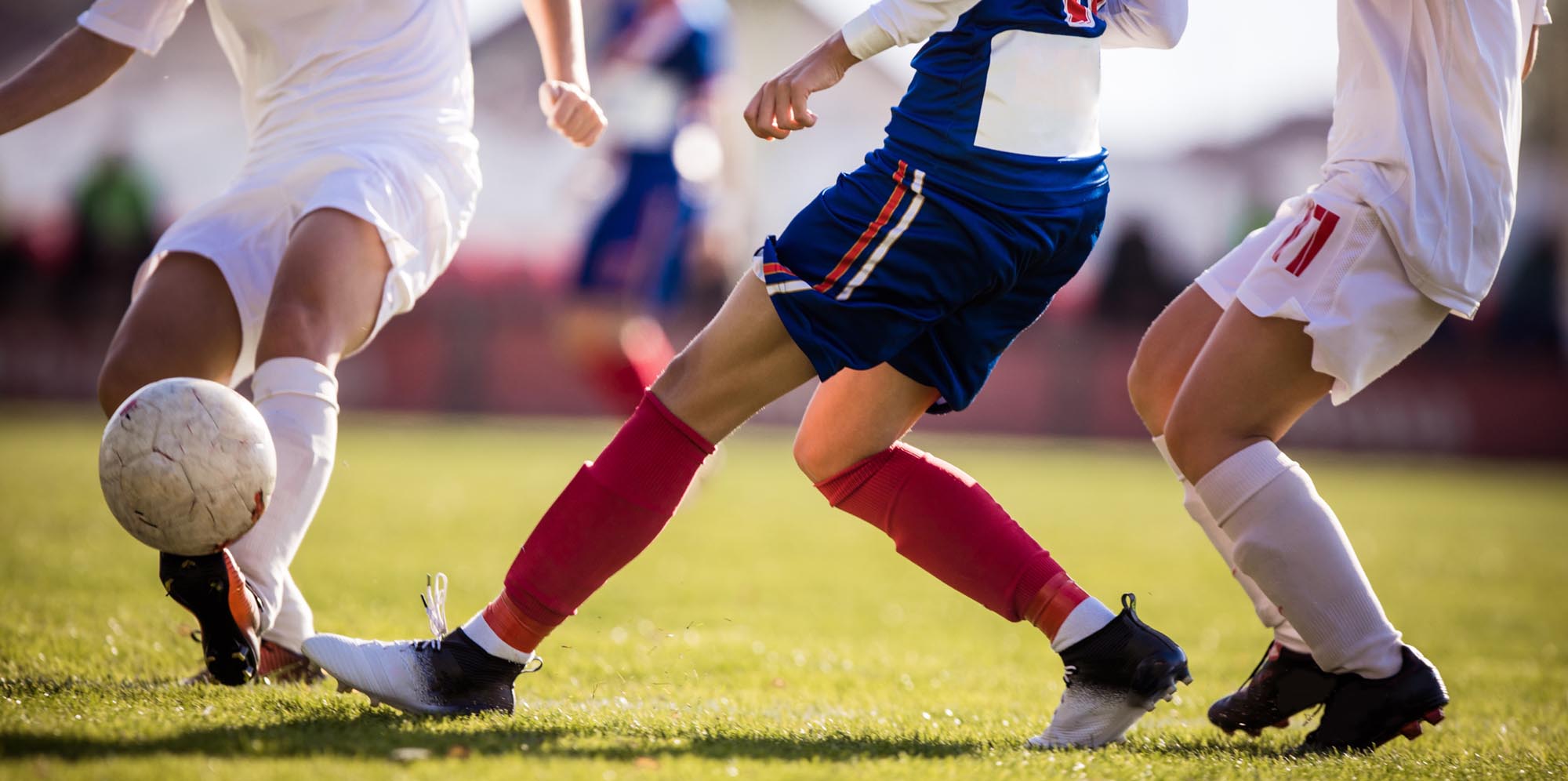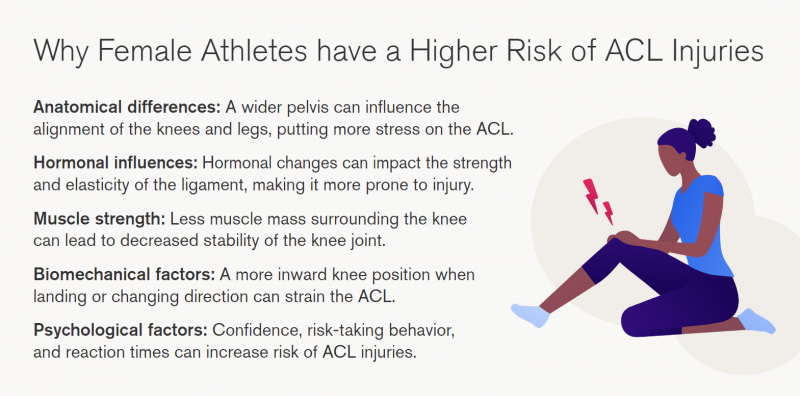Understanding ACL Injuries in Female Athletes: Risk Factors, Treatment and Prevention
March 15, 2024
Categories: Women's Health, Sports Medicine, Orthopaedics

The anterior cruciate ligament, or ACL, serves an important role in maintaining stability of the knee during physical activities. Despite its strength, the ACL is susceptible to injuries, particularly among female athletes.
We spoke with Mary K. Mulcahey, MD, FAAOS, FAOA - the division director of Sports Medicine at Loyola Medicine and Director of the Women's Sports Medicine program - to learn how female athletes can prevent ACL injuries.
"The anterior cruciate ligament is in the center of the knee and is absolutely critical to stability of the knee. We don’t need the ACL to be able to walk straight; however, it is essential for any side-to-side movement," says Dr. Mulcahey.
What is the ACL and why is it important?
The ACL connects the thigh bone (femur) to the shin bone (tibia), playing a major role in ensuring that our knees can withstand the demands of daily activities, especially in sports.
During athletic events, the ACL not only supports the knee during high-speed maneuvers but also aids in precise movements, like jumping, pivoting, and landing safely. Unfortunately, despite its crucial role, the ACL is prone to injuries, particularly in sports that involve cutting and pivoting and sudden changes in direction, such as basketball, soccer, and volleyball.
ACL injuries are not only common, but also exhibit a notable gender disparity. Research indicates that female athletes are significantly more likely to suffer from ACL injuries than their male counterparts. This increased risk is attributed to a combination of anatomical, hormonal, and biomechanical differences.
"Without the ACL, the knee doesn't function normally. It's so important for stability. If the ACL is not functioning properly, there is additional stress on other structures in the knee, such as the medial meniscus," says Dr. Mulcahey.
Why are female athletes at a higher risk for ACL injuries?
In the world of sports, female athletes face a unique set of challenges, particularly when it comes to injuries. Women are at a higher risk for ACL injuries because of various biological and physical factors.
"ACL tears are 2-8 times more common in female than male athletes due to a combination of non-modifiable and modifiable risk factors. Non-modifiable risk factors, things we cannot change, include gender-related differences in knee anatomy, like the size of the ACL and hormonal fluctuations during the menstrual cycle," says Dr. Mulcahey.
"However, there are risk factors that we can control, like hamstring and quadriceps strength, as well as how female athletes are landing during their sport."
There are many reasons why the risk of ACL injuries is higher for females.

How to prevent ACL injuries in women
Preventing ACL injuries in female athletes requires a multifaceted approach that starts with the foundational support system: coaches and parents. These key figures play a crucial role in instilling practices and behaviors that can significantly reduce the risk of ACL injuries.
Coaches and parents are on the front lines of prevention. They can encourage athletes to participate in injury prevention programs and ensure they are performing exercises correctly. By fostering an environment that prioritizes safety, proper technique, and strength training, coaches and parents can help female athletes build resilience against ACL injuries.
Implementing the following prevention strategies can set female athletes up for success.
Training and conditioning programs: Specialized training programs that focus on improving strength, flexibility, and balance are essential. These programs should include exercises that strengthen the muscles around the knees, hips, and core.
Proper techniques: Coaches should emphasize the importance of landing softly with knees slightly bent and hips back, reducing the force on the ACL.
Strength training: Targeted strength training, especially for the quadriceps and hamstrings, can provide the knee with more stability. Coaches and athletic trainers should include exercises that balance the strength of these muscle groups, as imbalances can increase the risk of injury.
Neuromuscular training: This involves exercises that improve the coordination and control of leg muscles, teaching the body to respond more effectively to the demands of sports.
Footwear and orthotic support: The right footwear can make a significant difference in reducing ACL injury risk. Athletic shoes that provide adequate support and fit the sport's specific demands can help in maintaining proper leg alignment and stability. In some cases, custom orthotics might be recommended to correct biomechanical imbalances.
"A key consideration to keep in mind for athletes, coaches and parents when creating or participating in injury prevention programs is that they shouldn't focus on just one type of exercise, but rather categories of exercises. There is strengthening, balance, core and lower extremity exercises and then progressions within each of those categories," says Dr. Mulcahey.
How to treat an ACL injury
When an ACL injury occurs, understanding the available treatment options is critical for a smooth and effective recovery. Treatment can vary depending on the severity of the injury, the athlete's age, activity level, and personal goals.
Immediately after an injury, the R.I.C.E. (Rest, Ice, Compression, and Elevation) method is a fundamental first step. Resting prevents further damage, ice reduces swelling, compression helps minimize inflammation, and elevation lowers swelling by reducing blood flow to the injured area.
Thankfully, not all ACL injuries require surgery. For less severe injuries or for individuals who engage in low-impact activities, physical therapy focused on strengthening the muscles around the knee to compensate for the torn ligament may be enough. Bracing may also be used to stabilize the knee during recovery.
In cases where the ACL is completely torn or if the individual wishes to return to high-impact sports, ACL reconstruction surgery is often recommended. This procedure involves replacing the torn ligament with a graft taken from another tendon in the patient's body or from a donor.
Physical therapy is an important component of recovery following injury and surgery. A comprehensive rehabilitation program is tailored to each patient’s needs, focusing on gradually rebuilding strength, flexibility, and stability in the knee. Physical therapists guide patients through various exercises and provide milestones to track progress.
When to see a doctor for an ACL tear
An ACL injury can range from a mild sprain to a complete tear, and understanding the signs that warrant a visit to the doctor can help ensure timely and appropriate care.
The moment an ACL injury occurs, it often comes with a distinct popping sound, followed by immediate pain and swelling in the knee. The joint may feel unstable or like it can't support your weight. If you experience these symptoms, particularly after a twisting motion or impact during sports, it's a sign to see a physician or orthopedic surgeon.
Early diagnosis is key to preventing further damage and starting the path to recovery. A doctor can assess the extent of the injury through a physical examination and imaging tests like x-rays and an MRI. When you visit a doctor, they will ask about how the injury occurred, symptoms you’ve experienced, and your medical history.
It's perfectly fine to ask about the full range of treatment options, the pros and cons of operative versus non-operative treatment, the expected timeline for recovery, and any potential complications. Inquire about what you can do to aid in your recovery and any lifestyle modifications that might be necessary. Remember, being proactive about your health is the first step toward healing.
The Women's Sports Medicine program at Loyola Medicine focuses on injury prevention and treatment for female athletes, as well as maintaining a high level of athletic performance.
Mary K. Mulcahey, MD, is an orthopaedic surgeon, division director of Sports Medicine, and Director of the Women's Sports Medicine program at Loyola Medicine. Dr. Mulcahey offers individualized, patient-centered care for both men and women. Her extensive knowledge of non-operative and operative management of orthopaedic and musculoskeletal conditions is reflected in her thorough explanation of injuries and treatment options.
Book an appointment today to see Dr. Mulcahey by self-scheduling an in-person or virtual appointment using myLoyola.
